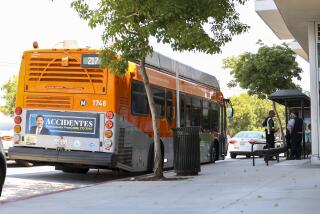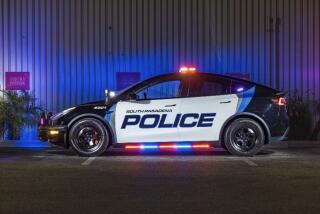Some Wary of a Shift to Trolleys
- Share via
Electric trolleys would be quieter and cleaner replacements for diesel buses on Victory and Ventura boulevards, an RTD planner argued in urging San Fernando Valley homeowners not to oppose the switch.
At a meeting Tuesday night at Millikan Junior High School in Sherman Oaks, several Victory Boulevard homeowners expressed fears that the overhead power lines for electric buses would be so unsightly that it would be difficult for them to sell their houses.
“I’m worried that it’s ugly, and that I’ll never be able to sell my house. And I don’t want to look at ugly myself,” said Gloria Marine, 63, who lives on Victory Boulevard in West Hills.
But Albert Perdon, assistant general manager of transit systems development for the Southern California Rapid Transit District, told the homeowners “it’s worth having these two wires to have clean air.”
“If you have been behind a bus as it emits black smoke, I am sure that you are familiar with the problem. When that happens to me, I am embarrassed that I work for the RTD,” Perdon said. “This is the trade-off we have to make.”
Many of the 40 other Valley residents at the meeting agreed with Perdon, and some expressed anger at those who seemed more concerned with their property values than reducing air pollution.
“When you get behind a diesel bus, you just choke on the fumes,” said Chatsworth resident George Boyd, 67. “I think it would improve things considerably to have an electric trolley.”
The meeting was one of a series of public forums that have been held by the transit district as part of a $750,000 study of the feasibility of installing electric trolley lines along bus routes throughout the city.
Installing electric trolleys--which emit no pollution themselves, although electric power plants do--was one of several sweeping changes ordered last year by the South Coast Air Quality Management District to achieve cleaner air. Although the electric trolleys are more expensive then diesel buses--$400,000 as opposed to $250,000--they last an average of 25 years instead of the 12-year life of diesel buses and maintenance costs are 30% lower, transit officials said.
The study will explore the environmental impact and costs and will recommend initial routes. It is expected to be completed in March and will be presented to the RTD executive board and the County Transportation Commission for approval. Funding for the project will come from county Proposition C, which collects an additional quarter-cent sales tax for transportation purposes.
Electric trolleys have been used for years in cities such as Seattle, San Francisco and Vancouver, Canada. Los Angeles had its own electric trolley system, but it was dismantled in the 1960s. Now, Perdon said, “we are beginning to think that wasn’t such a hot idea.”
Ventura Boulevard or Victory Boulevard are likely streets for some of the initial trolley lines because buses along those streets already have heavy ridership, Perdon said. He said county officials would try to design the overhead wires and the poles that support them so they are unobtrusive.
Researchers are working on methods to bury the power cables in pavement, but the technology is not sufficiently advanced to use, Perdon said.
More to Read
Sign up for Essential California
The most important California stories and recommendations in your inbox every morning.
You may occasionally receive promotional content from the Los Angeles Times.










